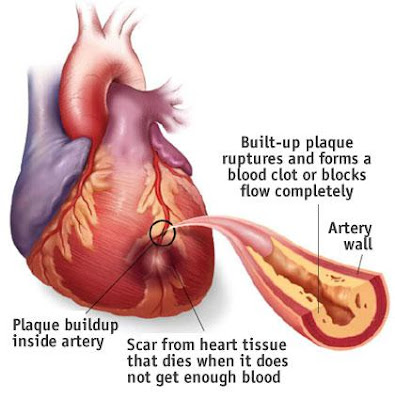Infarction
Myocardial Infarction results from the complete occlusion of a coronary artery. The infarcted area of myocardium becomes necrotic (dead), so it cant depolarize or contract.
Although the heart's chambers are filled with blood, the myocardium's own blood supply is provided exclusively by the coronary arteries. A coronary artery can be gradually narrowed by lipid deposits that become atheromatous plaque beneath the intima lining of the vessel. The intima may eventually rupture, exposing the plaque to the blood within the artery. This initiates the immediate formation of a clot (thrombus). The vessel, already narrowed by the plaque, becomes totally occluded by the thrombus. Instantly the infarcted area of the ventricle (without a blood supply) becomes necrotic. Ventricular foci in the hypoxic area around the infarct become very irritable, this can produce deadly ventricular arrhythmias.
Myocardial Infarction implies the complete occlussion of a coronary artery, which we can diagnose with the EKG. The electrocardiogram will also tell us which coronary artery or coronary branch is occluded, and it can even reveal any blocks in the ventricular conduction caused by the infarction. By careful interpretation of the EKG, we can also determine if a coronary vessel is narrowed, rendering a decreased blood supply to the heart. Practical livesaving knowledge.
Myocardial infarction is due to the occlussion of a coronary artery supplying the left ventricle, so an area of the heart is without a blood supply and suffers necrosis.
The terms "myocardial infarction", "coronary occlusion" and "heart attack" refer to the same serious phenomenon.
The heart derives its own blood supply from the coronary arteries, so when a coronary artery or one of its major branches is occluded, an area of the myocardium is without blood supply.
The infarcted (necrotic) area is primarily in the left ventricle; deadly arrhythmias may result.
We understand that the coronary arteries also supply the right ventricle, so there is often some involvement of the right ventricle,. But since most of the critical problems originate in left ventricular infarcts, myocardial infarction is usually conceptualized in term of the left ventricle.
Commonly, the thick left ventricle that suffers myocardial infarction
The left ventricle is the thickest chamber of the heart; so if the coronary arteries are narrowed, the left ventricle (which uses the greatest blood supply) is the first to suffer from an obstructed coronary artery.
Blood is pumped to all parts of the body by the powerful, thick, left ventricle.
When we describe infarcts by location, we are speaking of an area within the left ventricle. Coronary arteries to the left ventricle usually send smaller branches to other regions of the heart, so an infarction of the left ventricle can include a small portion of another chamber.
The necrotic infarcted area of the ventricle (that has no blood supply) is electrically dead and cannot depolarize.
Infarctions usually involve an area of the wall of the left ventricle.
An area of infarction cannot be depolarized because the cells there are without s blood supply, so they are necrotic (functionally dead).
This necrotic infarcted area produces an electrical void, while the rest of the heart (with an adequate blood supply) functions as usual. The infarcted region does not depolarize, so it does not contract, thereby impairing the muscular function of the left ventricle. Also, hypoxic ventricular foci nearby are often the source of serious ventricular arrhythmias.
The myocardial infarction triad is "ischemia", "injury" and "necrosis", but any of the three may occur alone.
Necrosis (death) of a ventricular region produces dead mayocardial cells that cannot depolarize.
The myocardial infarction triad is the basis for recognizing and diagnosing a myocardial infarction.
The word hypoxia means decreased oxygen; in the heart, it is usually caused by ischemia, which literally means reduced blood supply (diminished blood flow).
"Ischemia", "injury" and "necrosis" need not all be present at once in order to establish the diagnosis of myocardial infarction. Routine EKG interpretation requires checking these infarction criteria.
Credit: Dale Dubin-RapidInterpreatation Of EKG






No comments:
Post a Comment